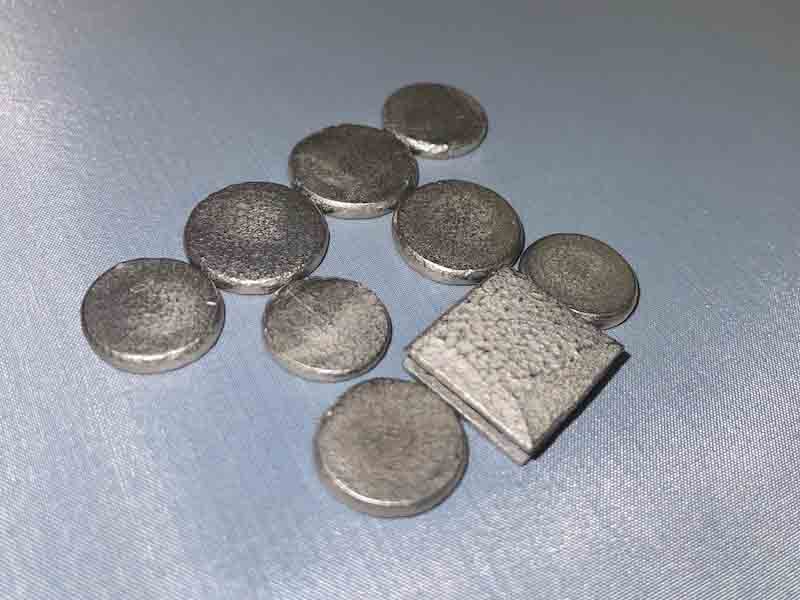Nickel plating, in its various forms and applications, continues to be a workhorse of the metal finishing industry.
 Stephen F. Rudy CEFThe majority of requirements are well acknowledged. Some of these are: automotive, personal care, medical, engineering, aerospace, military and communications. Over the years, practical developments have guided the optimum procedures and maintenance to best achieve desired finishes, readily and economically. Let’s review some items of significance that should keep us on track.
Stephen F. Rudy CEFThe majority of requirements are well acknowledged. Some of these are: automotive, personal care, medical, engineering, aerospace, military and communications. Over the years, practical developments have guided the optimum procedures and maintenance to best achieve desired finishes, readily and economically. Let’s review some items of significance that should keep us on track.
Nickel Plating – Plain And Simple
We all should understand the basics of electroplating. If you have any areas of concern or need a “tune up,” I suggest consulting NASF for guidance as to area training sessions and the multitude of helpful articles and books that are available. Suppliers also will be helpful in this regard, offering practical training and workshops.
Nickel plating itself provides a theoretical 100% efficiency. By accounting for hydrogen gas evolution, this detraction generally reduces working efficiency to approximately 93-95%. This fact is incorporated into charts that provide nickel thickness data. You may be familiar with using these helpful charts. If not, the information is usually given in a logical breakdown consisting of plating time per plating current density to obtain deposit thickness. Most texts, guidebooks and technical bulletins contain these helpful charts. The following chart encompasses the general information, as a guide to setting the nickel plating process for specific jobs or projects.
Electrodeposition of Nickel based on 95% Cathode Efficiency
A= Deposit Thickness (u m); B=Weight per unit area (G/dm2); C=Amp Hours per unit (Ah/dm2)
| A | B | C | 0.5 | 1 | 1.5 | 2 | 3 | 4 | 5 | 6 | 8 | 10 | 12 |
| 2 | 0.18 | 0.17 | 20 | 10 | 6.8 | 5.1 | 3.4 | 2.6 | 2 | 1.7 | 1.3 | 1 | 0.9 |
| 4 | 0.36 | 0.34 | 41 | 20 | 14 | 10 | 6.8 | 5.1 | 4.1 | 3.4 | 2.6 | 2 | 1.7 |
| 6 | 0.53 | 0.51 | 61 | 31 | 20 | 15 | 10 | 7.7 | 6.1 | 5.1 | 3.8 | 3.1 | 2.6 |
| 8 | 0.71 | 0.68 | 82 | 41 | 27 | 20 | 14 | 10 | 8.2 | 6.8 | 5.1 | 4.1 | 3.4 |
| 10 | 0.89 | 0.85 | 100 | 51 | 34 | 26 | 17 | 13 | 10 | 8.5 | 6.4 | 5.1 | 4.3 |
| 12 | 1.1 | 1 | 120 | 61 | 41 | 31 | 20 | 15 | 12 | 10 | 7.7 | 6.1 | 5.1 |
| 14 | 1.2 | 1.2 | 140 | 71 | 48 | 36 | 24 | 18 | 14 | 12 | 8.9 | 7.1 | 6 |
| 16 | 1.4 | 1.4 | 160 | 82 | 54 | 41 | 27 | 20 | 16 | 14 | 10 | 8.2 | 6.8 |
| 18 | 1.6 | 1.5 | 180 | 92 | 61 | 46 | 31 | 23 | 18 | 15 | 11 | 9.2 | 7.7 |
| 20 | 1.8 | 1.7 | 200 | 100 | 68 | 51 | 34 | 26 | 20 | 17 | 13 | 10 | 8.5 |
| 40 | 3.6 | 3.4 | 410 | 200 | 140 | 100 | 68 | 51 | 41 | 34 | 26 | 20 | 17 |
| 60 | 5.3 | 5.1 | 610 | 310 | 200 | 150 | 100 | 77 | 61 | 51 | 38 | 31 | 26 |
The plater uses this information to help in determining the specific, required nickel plating cycle, which leans heavily into their costs to do these related plating jobs. It is therefore very important to not overplate (losing money doing the quoted job). For the customer, over plated surfaces may not connect in final assembly. Equally critical is not to underplate, as any required specification, salt spray criteria, etc. would not be met. This leads us to reject parts. Rejects are very expensive. The estimated cost to strip and re-plate can actually triple the cost of processing parts in one cycle. Worse yet, reject parts may have to be disposed. In this regard, profit is essentially wiped out. As we have experienced, the cost of nickel anodes has fluctuated in varying levels of price. This fact also can significantly affect the cost of processing parts as related to pricing a job.
Most shops have nickel plating deposit thickness testers, in the form of x-ray (non-destructive), de-plate (destructive) or magnetic. The old stand-by method can also be used to measure thickness. This is the weight method. Using a part with an easy-to-measure surface area, such as a Hull Cell panel, weigh the panel (A) after it has been nickel plated. Be careful to use corresponding units for values. First multiply the surface area by the density of nickel (B). Next, divide (A) by (B) to get the average deposit thickness of nickel.
Thickness and Current Distribution
 In a practical sense, industry does not make a living plating easy-to-process flat panels, or just one part at a time. The driving force or goal is to deposit uniform coating thicknesses of nickel on all significant surfaces of parts. In this way, critical service life parameters, specifications and corrosion requirements can be met. Every nickel bath has an electrical resistance. Each part has, by designed geometry, significant surfaces, some closer to the anode, with others recessed. Consider current as being lazy. Its desired flow from anode to cathode (the part) is to reach surface areas closer to the anode first. These surfaces are commonly referred to as the high current density areas. Recessed areas get less current, resulting in a comparatively thinner deposit. In effect, the rate of deposition of nickel in the high current density areas will be greater than that in the low current density areas. Think of this as shorter distance, lower electrical resistance. This phenomenon is referred to as current distribution. When racks of parts or barrel loads are planned, the plating deposition chart previously given is very useful. It is referenced to determine sufficient plating times at various current densities to achieve the overall desired deposit thickness on significant surfaces.
In a practical sense, industry does not make a living plating easy-to-process flat panels, or just one part at a time. The driving force or goal is to deposit uniform coating thicknesses of nickel on all significant surfaces of parts. In this way, critical service life parameters, specifications and corrosion requirements can be met. Every nickel bath has an electrical resistance. Each part has, by designed geometry, significant surfaces, some closer to the anode, with others recessed. Consider current as being lazy. Its desired flow from anode to cathode (the part) is to reach surface areas closer to the anode first. These surfaces are commonly referred to as the high current density areas. Recessed areas get less current, resulting in a comparatively thinner deposit. In effect, the rate of deposition of nickel in the high current density areas will be greater than that in the low current density areas. Think of this as shorter distance, lower electrical resistance. This phenomenon is referred to as current distribution. When racks of parts or barrel loads are planned, the plating deposition chart previously given is very useful. It is referenced to determine sufficient plating times at various current densities to achieve the overall desired deposit thickness on significant surfaces.
Throwing Power
 Upon mixing current distribution and thickness, we get another popular term, which is throwing power. The electrochemical characteristics of the nickel plating solution have an effect on current distribution. There is a significant relationship affected by cathode polarization and efficiency, part geometry and solution conductivity. In turn, how these parameters interact affects the solution throwing power.
Upon mixing current distribution and thickness, we get another popular term, which is throwing power. The electrochemical characteristics of the nickel plating solution have an effect on current distribution. There is a significant relationship affected by cathode polarization and efficiency, part geometry and solution conductivity. In turn, how these parameters interact affects the solution throwing power.
The effect is a measure of desired, uniform deposits where polarization and deposit efficiency are not a factor. There are, once again, tables that take throwing power into account, helping the finisher achieve desired plating cycles. Throwing power in % at primary plating current density ratios is given versus the average plating current density. For example, at 40 amps/ft2, the % throwing power is 8% at a ratio of 5:1. Throwing power is 14% at ratio of 25:1.
Studies of nickel throwing power have confirmed that reducing current density, while increasing temperature, pH, and conductivity, will increase the throwing power. Chemical composition of the plating bath and corresponding operating parameters do affect throwing power. By controlling these parameters, the metal distribution on plated parts will be improved. Perhaps more commonly, this is also achieved by optimizing racking or barrel load size. There are several variables to determine and adjust test plating with subsequent thickness measurements, which will help to determine and set these variables into a specific operating range.
In many instances, the accumulated knowledge of plating different jobs makes the determination of how to set up the cycle easier. References in the form of useful tables abound. Most shops incorporate a lab that includes analytical capability along with thickness measuring devices. Suppliers also offer their technical expertise in this regard, especially those who develop proprietary brightener additive systems. Many specification sheets detail specific operating parameters, as an easy guide to prepare the plating cycle.
Stephen F. Rudy, CEF, is president of Chem Analytic, and has written extensively about the finishing industry. Visit www.chemanalytic.com or call him at 917-604-5001.



































